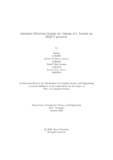| dc.contributor.advisor | Hossain, Dr. Muhammad Iqbal | |
| dc.contributor.advisor | Rahman, Rafeed | |
| dc.contributor.author | Farhan | |
| dc.contributor.author | Mueth Ul Ehsan Ananno | |
| dc.contributor.author | Tanzil Talat Anonto | |
| dc.contributor.author | Sazzad Alam Tomal | |
| dc.date.accessioned | 2022-11-15T08:33:58Z | |
| dc.date.available | 2022-11-15T08:33:58Z | |
| dc.date.copyright | 2022 | |
| dc.date.issued | 2022-01 | |
| dc.identifier.other | ID: 17201109 | |
| dc.identifier.other | ID: 17301142 | |
| dc.identifier.other | ID: 17201078 | |
| dc.identifier.other | ID: 16301124 | |
| dc.identifier.uri | http://hdl.handle.net/10361/17571 | |
| dc.description | This thesis is submitted in partial fulfillment of the requirements for the degree of Bachelor of Science in Computer Science and Engineering, 2022. | en_US |
| dc.description | Cataloged from PDF version of thesis. | |
| dc.description | Includes bibliographical references (pages 32-33). | |
| dc.description.abstract | In recent times the number of IoT devices have increased massively but the security
of these devices has not been upgraded. Due to this huge number, achieving high
security is a big challenge. The use of a classic centralized design in IoT systems can
compromise security. Gadgets in the Internet of Things have sensors that collect
information about their surroundings which is required for the correct operation of
IoT setups. If not secured, or if stolen or otherwise hacked, this data could have a
number of undesirable consequences. The Internet of Things devices use a variety
of communication protocols. The MQTT protocol is one of the protocols that has
previously been standardized by ISO. Because of its low memory use and low band width requirements, this protocol is popular among IoT developers. Occasionally,
IoT devices communicate sensitive data that is only meant for authorized devices.
The protocol, on the other hand, merely authenticates the security mechanism,
which does not encrypt the data being carried by default which is a major concern
in terms of data privacy, authentication, and data integrity. This paper highlights
numerous reasons why many IoT systems do not have proper security mechanisms
in place. Following that, it also shows and explains how we may easily attack this
protocol in a variety of assault scenarios. Finally, after learning about the flaws in
We can increase our security by looking into this protocol. awareness, particularly
of the MQTT protocol, and then implementation. | en_US |
| dc.description.statementofresponsibility | Farhan | |
| dc.description.statementofresponsibility | Mueth Ul Ehsan Ananno | |
| dc.description.statementofresponsibility | Tanzil Talat Anonto | |
| dc.description.statementofresponsibility | Sazzad Alam Tomal | |
| dc.format.extent | 33 Pages | |
| dc.language.iso | en_US | en_US |
| dc.publisher | Brac University | en_US |
| dc.rights | Brac University theses are protected by copyright. They may be viewed from this source for any purpose, but reproduction or distribution in any format is prohibited without written permission. | |
| dc.subject | MQTT | en_US |
| dc.subject | Attacks | en_US |
| dc.subject | Security | en_US |
| dc.subject | Centralized | en_US |
| dc.subject.lcsh | Internet of things | |
| dc.subject.lcsh | Computer networks | |
| dc.title | Intrusion detection system for various IoT attacks on MQTT protocol | en_US |
| dc.type | Thesis | en_US |
| dc.contributor.department | Department of Computer Science and Engineering, Brac University | |
| dc.description.degree | B. Computer Science and Engineering | |

